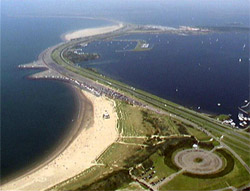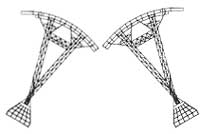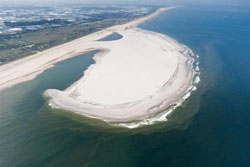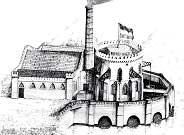This specific Dutch theme reflects the age-long struggle of the Dutch
against the water. Countless times the sea flooded the land and rivers
burst their banks.
Delta works
At the flood of 1953 in the south-west
of the Netherlands there were over 1800 casualties.
The Deltaplan
for closing the estuaries was born.

|


|
www.deltawerken.com
© Stichting Deltawerken Online |
Below sealevel
About 30% of the Netherlands lies below the sealevel, so the Dutch
became real masters in keeping their feet dry. It was either pumping
or drowning.
Masterpieces of hydraulic engineering
Dikes and pumping-stations are evidence of the struggle against
the water. Various hydraulic works such as the 30km long IJsselmeer
Dam (Enclosing Dike), the Eastern Scheldt storm-surge barrier of
the Deltaworks and the
Maeslant Kering ( Storm surge barrier of Hook of Holland ) are part of our programme.
Storm Surge Barrier as long as Eifeltower
| |
Storm Surge Barrier |
 |
 |
| This Maeslant Kering has enormous dimensions.
|
Building with nature : the Sand Enging

Aerial view of Sand Engine
© www.beeldbank.rws.nl, Rijkswaterstaat
The Sand engine is a large amount of sand that has been deposited in front of the western coast of the province of Zuid Holland. Wind, waves and sea current will spread the sand around. This concept which is called building with nature will contribute to the coastal safety in the long term and create more space for nature and recreation in this densely populated part of Holland.
Deep in their hearts the Dutch know that the sea will never be tamed. The changing climate poses new challenges for them . And the Dutch wouldn’t be the Dutch if they didn’t go in search of new, innovative solutions for the impending rising sea level. The Sand Engine could be such a solution. An innovative way of large-scale sand suppletion whereby the Dutch engineers use the power of the wind and waves to create new land. Building with nature: The Dutch let the sea do the hard work. In this way they combine two objectives. creating more space for nature and recreation and making the coastline more solid and safer.
A visit to the Storm surge barrier of Hook of Holland can be combined with a visit to the site of the Sand Engine on the North Sea coast
Steam pumping-stations
The largest Steam Pumping Station in the world, the Ir. D.F. Woudagemaal,
also on the Unesco World Heritage list, and a number of other steam
pumping- stations at various locations can also be visited.
International historic landmark
 The
American Society of Mechanical Engineers (ASME) designated the Cruquius
steam pumping station the 33rd International Historic Landmark in
1991. The
American Society of Mechanical Engineers (ASME) designated the Cruquius
steam pumping station the 33rd International Historic Landmark in
1991.
© Museum De Cruquius
Traces of past breaches in dikes
A tour along a winding dikeroad is of course one of the possibilities
as well as a boattrip on the many Dutch waters.
Cornfields on seabed
The reclamation of the Zuyderzee where seabed was turned into fertile
arable land shows that the Dutch not only took a defensive attitude
towards the threatening water but also an offensive approach.
Floating cellar
In contrast with the many large scale hydraulic works there is
the small scale floating cellar where a citizen long ago in an ingenious
way fought against rising groundwater.
Water works : small-scale water management in the Netherland
One of the activities the crown prince of the Netherlands, His
Royal Highness Prince Willem Alexander, occupies himself with is
water management. In 2002 he played an important role at the World
Water Platform in Johannesburg by giving the opening speech at
the Water Dome and presenting his policy paper "No Water, No Future".
There is a water shortage in many countries. The Netherlands,
however, often has a surplus of water, especially river water.
With global warming progressing an increase in precipitation and
consequently a rise in stream flow in rivers in Europe is expected.
One of the scenarios shows a rise of the sea level of 25 cm per
century
and a normative river flow of the Rhine at Lobith (the
Netherlands) of 16,800 m³ per second (currently 16,000m³ per second).
Such a scenario will necessitate measures aimed at dealing with
a surplus of water and the protection of the population, also on
an international scale.
To this end the Dutch government launched
the "Room for the River" project.
However, much can be done about water management locally, in close
collaboration with the population. Let the water do its work. MORE
INFO >> |



